ESP AUDI A4 1998 B5 / 1.G Brakes ESP Bosch 5.3 Workshop Manual
[x] Cancel search | Manufacturer: AUDI, Model Year: 1998, Model line: A4, Model: AUDI A4 1998 B5 / 1.GPages: 27, PDF Size: 0.21 MB
Page 1 of 27
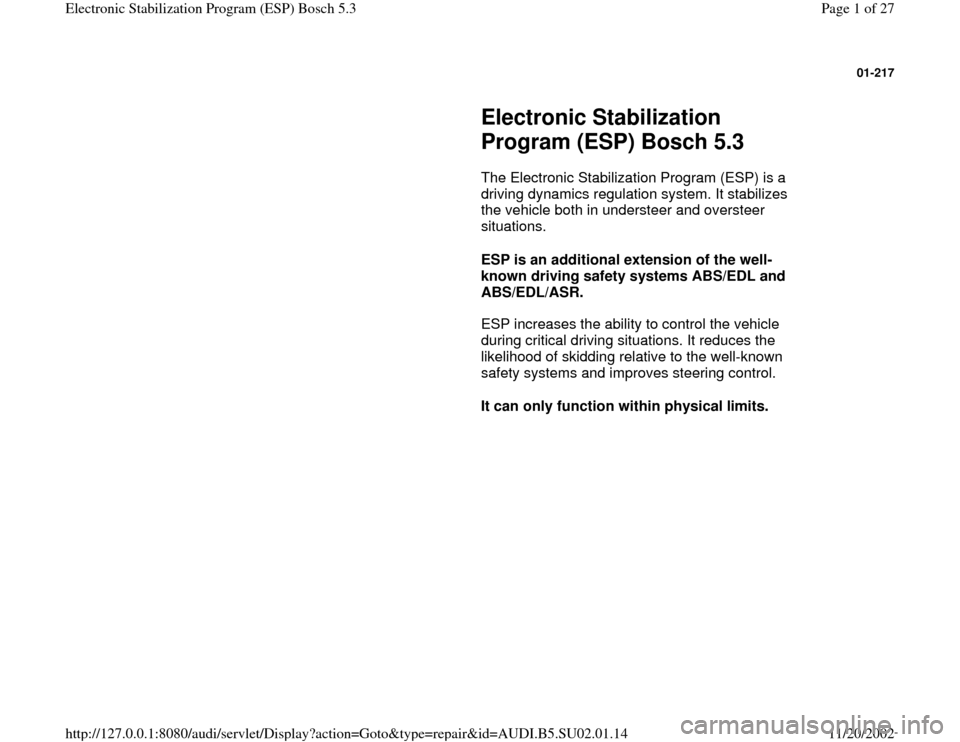
01-217
Electronic Stabilization
Program (ESP) Bosch 5.3
The Electronic Stabilization Program (ESP) is a
driving dynamics regulation system. It stabilizes
the vehicle both in understeer and oversteer
situations.
ESP is an additional extension of the well-
known driving safety systems ABS/EDL and
ABS/EDL/ASR.
ESP increases the ability to control the vehicle
during critical driving situations. It reduces the
likelihood of skidding relative to the well-known
safety systems and improves steering control.
It can only function within physical limits.
Pa
ge 1 of 27 Electronic Stabilization Pro
gram
(ESP
) Bosch 5.3
11/20/2002 htt
p://127.0.0.1:8080/audi/servlet/Dis
play?action=Goto&t
yp
e=re
pair&id=AUDI.B5.SU02.01.14
Page 2 of 27
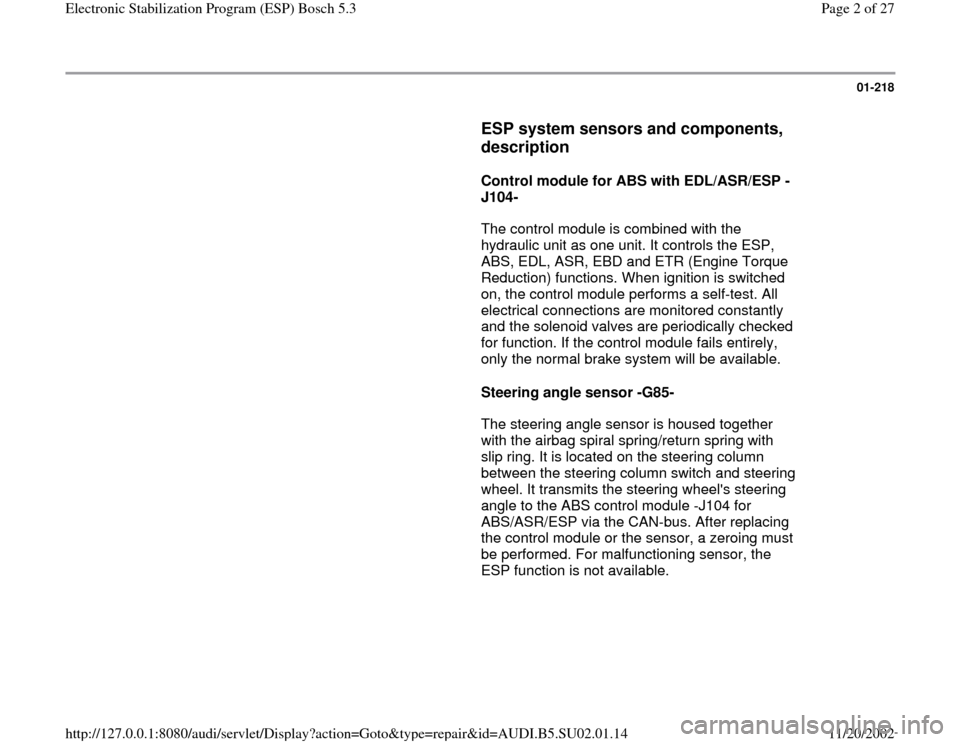
01-218
ESP system sensors and components,
description
Control module for ABS with EDL/ASR/ESP -
J104-
The control module is combined with the
hydraulic unit as one unit. It controls the ESP,
ABS, EDL, ASR, EBD and ETR (Engine Torque
Reduction) functions. When ignition is switched
on, the control module performs a self-test. All
electrical connections are monitored constantly
and the solenoid valves are periodically checked
for function. If the control module fails entirely,
only the normal brake system will be available.
Steering angle sensor -G85-
The steering angle sensor is housed together
with the airbag spiral spring/return spring with
slip ring. It is located on the steering column
between the steering column switch and steering
wheel. It transmits the steering wheel's steering
angle to the ABS control module -J104 for
ABS/ASR/ESP via the CAN-bus. After replacing
the control module or the sensor, a zeroing must
be performed. For malfunctioning sensor, the
ESP function is not available.
Pa
ge 2 of 27 Electronic Stabilization Pro
gram
(ESP
) Bosch 5.3
11/20/2002 htt
p://127.0.0.1:8080/audi/servlet/Dis
play?action=Goto&t
yp
e=re
pair&id=AUDI.B5.SU02.01.14
Page 3 of 27
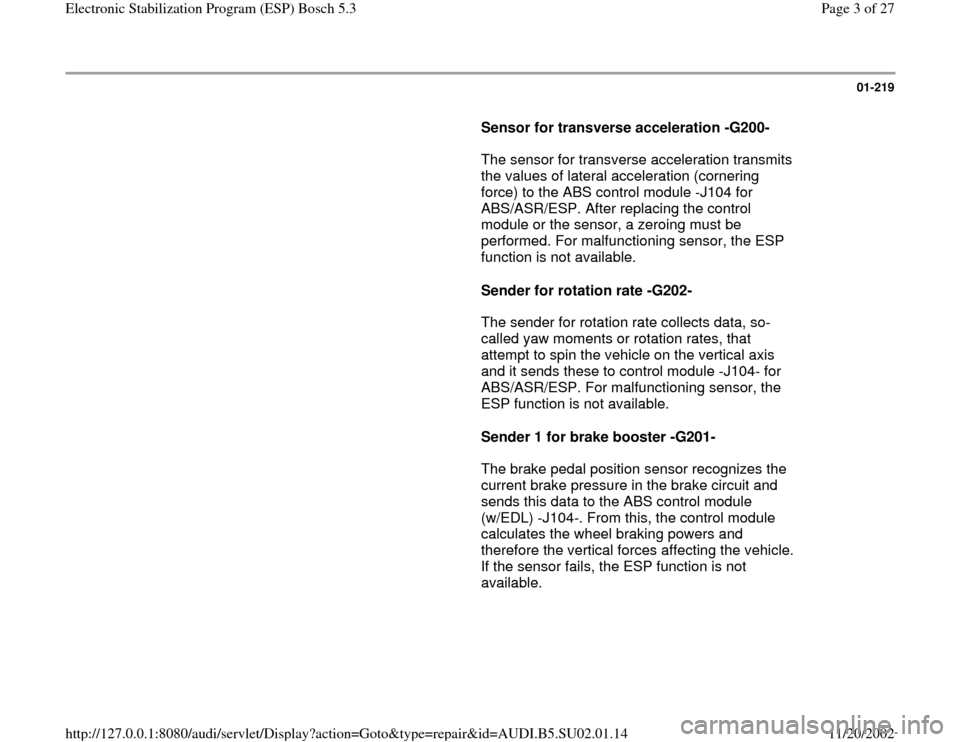
01-219
Sensor for transverse acceleration -G200-
The sensor for transverse acceleration transmits
the values of lateral acceleration (cornering
force) to the ABS control module -J104 for
ABS/ASR/ESP. After replacing the control
module or the sensor, a zeroing must be
performed. For malfunctioning sensor, the ESP
function is not available.
Sender for rotation rate -G202-
The sender for rotation rate collects data, so-
called yaw moments or rotation rates, that
attempt to spin the vehicle on the vertical axis
and it sends these to control module -J104- for
ABS/ASR/ESP. For malfunctioning sensor, the
ESP function is not available.
Sender 1 for brake booster -G201-
The brake pedal position sensor recognizes the
current brake pressure in the brake circuit and
sends this data to the ABS control module
(w/EDL) -J104-. From this, the control module
calculates the wheel braking powers and
therefore the vertical forces affecting the vehicle.
If the sensor fails, the ESP function is not
available.
Pa
ge 3 of 27 Electronic Stabilization Pro
gram
(ESP
) Bosch 5.3
11/20/2002 htt
p://127.0.0.1:8080/audi/servlet/Dis
play?action=Goto&t
yp
e=re
pair&id=AUDI.B5.SU02.01.14
Page 4 of 27
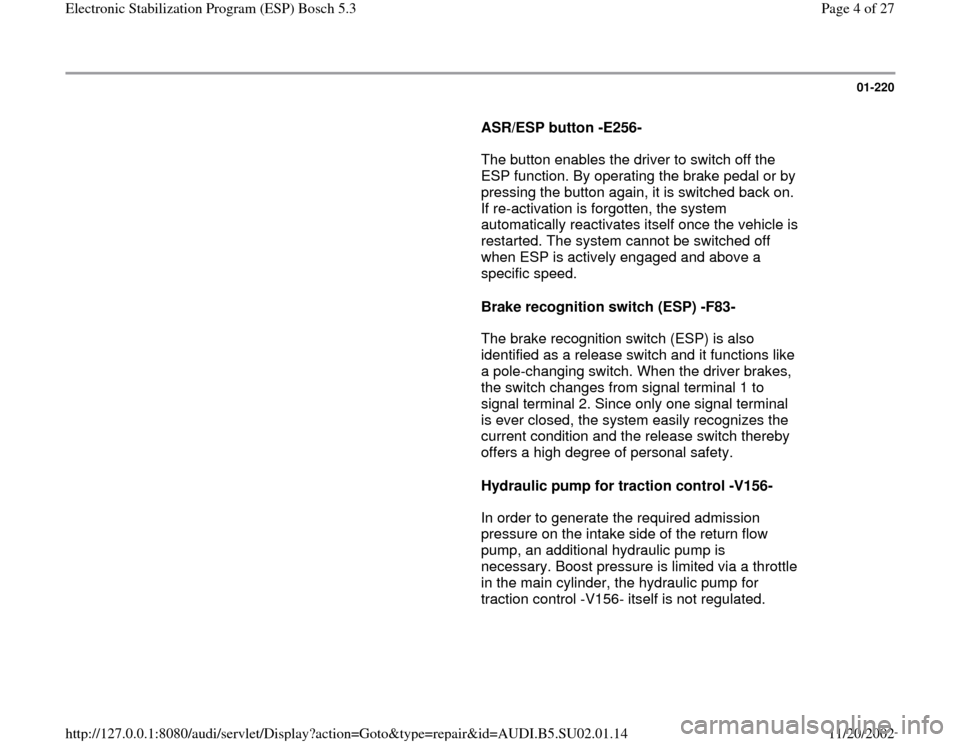
01-220
ASR/ESP button -E256-
The button enables the driver to switch off the
ESP function. By operating the brake pedal or by
pressing the button again, it is switched back on.
If re-activation is forgotten, the system
automatically reactivates itself once the vehicle is
restarted. The system cannot be switched off
when ESP is actively engaged and above a
specific speed.
Brake recognition switch (ESP) -F83-
The brake recognition switch (ESP) is also
identified as a release switch and it functions like
a pole-changing switch. When the driver brakes,
the switch changes from signal terminal 1 to
signal terminal 2. Since only one signal terminal
is ever closed, the system easily recognizes the
current condition and the release switch thereby
offers a high degree of personal safety.
Hydraulic pump for traction control -V156-
In order to generate the required admission
pressure on the intake side of the return flow
pump, an additional hydraulic pump is
necessary. Boost pressure is limited via a throttle
in the main cylinder, the hydraulic pump for
traction control -V156- itself is not regulated.
Pa
ge 4 of 27 Electronic Stabilization Pro
gram
(ESP
) Bosch 5.3
11/20/2002 htt
p://127.0.0.1:8080/audi/servlet/Dis
play?action=Goto&t
yp
e=re
pair&id=AUDI.B5.SU02.01.14
Page 5 of 27
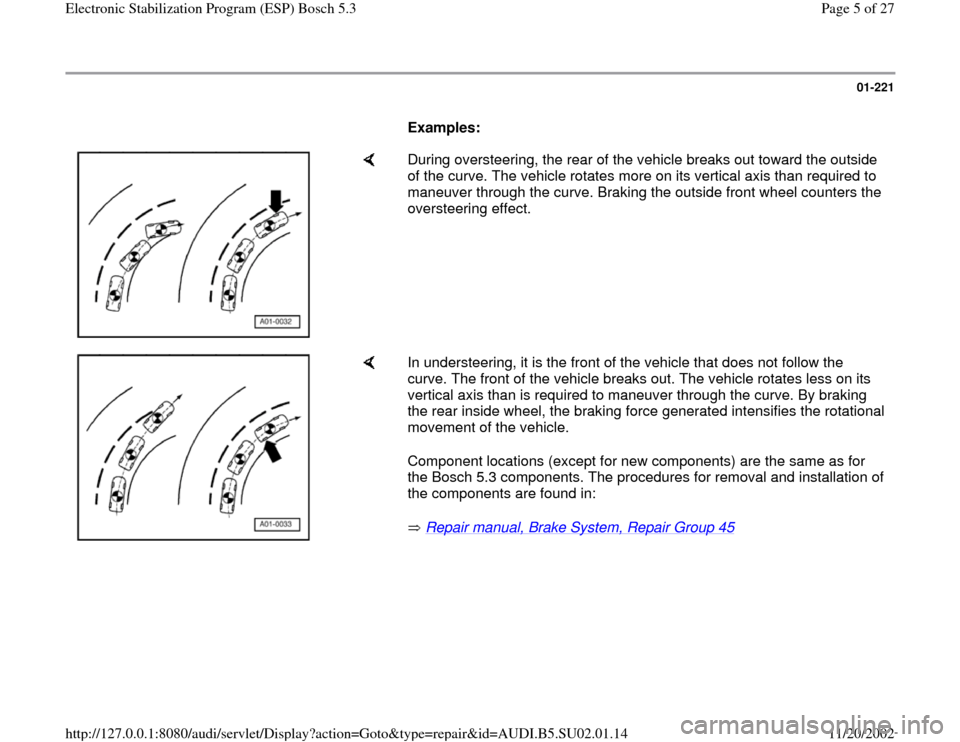
01-221
Examples:
During oversteering, the rear of the vehicle breaks out toward the outside
of the curve. The vehicle rotates more on its vertical axis than required to
maneuver through the curve. Braking the outside front wheel counters the
oversteering effect.
In understeering, it is the front of the vehicle that does not follow the
curve. The front of the vehicle breaks out. The vehicle rotates less on its
vertical axis than is required to maneuver through the curve. By braking
the rear inside wheel, the braking force generated intensifies the rotational
movement of the vehicle.
Component locations (except for new components) are the same as for
the Bosch 5.3 components. The procedures for removal and installation of
the components are found in:
Repair manual, Brake System, Repair Group 45
Pa
ge 5 of 27 Electronic Stabilization Pro
gram
(ESP
) Bosch 5.3
11/20/2002 htt
p://127.0.0.1:8080/audi/servlet/Dis
play?action=Goto&t
yp
e=re
pair&id=AUDI.B5.SU02.01.14
Page 6 of 27
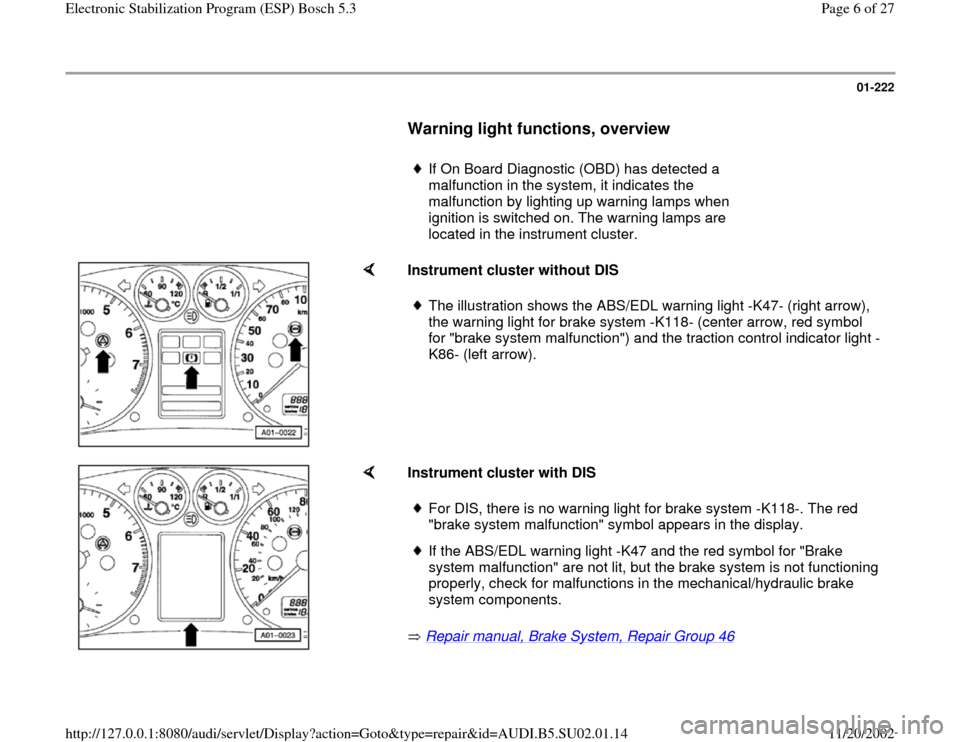
01-222
Warning light functions, overview
If On Board Diagnostic (OBD) has detected a
malfunction in the system, it indicates the
malfunction by lighting up warning lamps when
ignition is switched on. The warning lamps are
located in the instrument cluster.
Instrument cluster without DIS
The illustration shows the ABS/EDL warning light -K47- (right arrow),
the warning light for brake system -K118- (center arrow, red symbol
for "brake system malfunction") and the traction control indicator light -
K86- (left arrow).
Instrument cluster with DIS
Repair manual, Brake System, Repair Group 46
For DIS, there is no warning light for brake system -K118-. The red
"brake system malfunction" symbol appears in the display. If the ABS/EDL warning light -K47 and the red symbol for "Brake
system malfunction" are not lit, but the brake system is not functioning
properly, check for malfunctions in the mechanical/hydraulic brake
system components.
Pa
ge 6 of 27 Electronic Stabilization Pro
gram
(ESP
) Bosch 5.3
11/20/2002 htt
p://127.0.0.1:8080/audi/servlet/Dis
play?action=Goto&t
yp
e=re
pair&id=AUDI.B5.SU02.01.14
Page 7 of 27
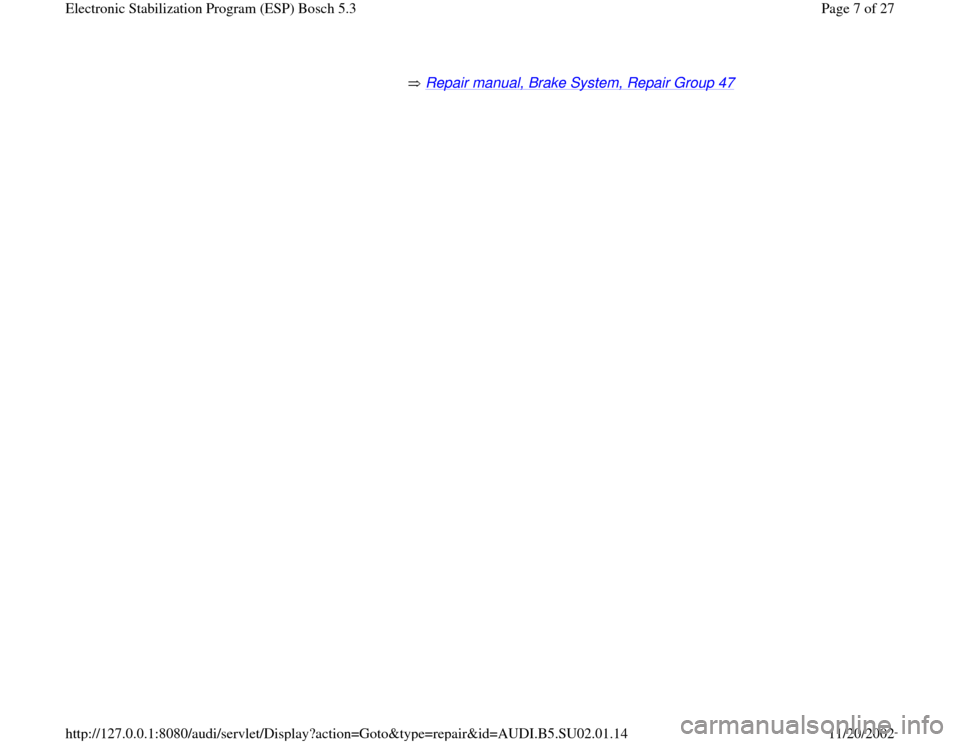
Repair manual, Brake System, Repair Group 47
Pa
ge 7 of 27 Electronic Stabilization Pro
gram
(ESP
) Bosch 5.3
11/20/2002 htt
p://127.0.0.1:8080/audi/servlet/Dis
play?action=Goto&t
yp
e=re
pair&id=AUDI.B5.SU02.01.14
Page 8 of 27
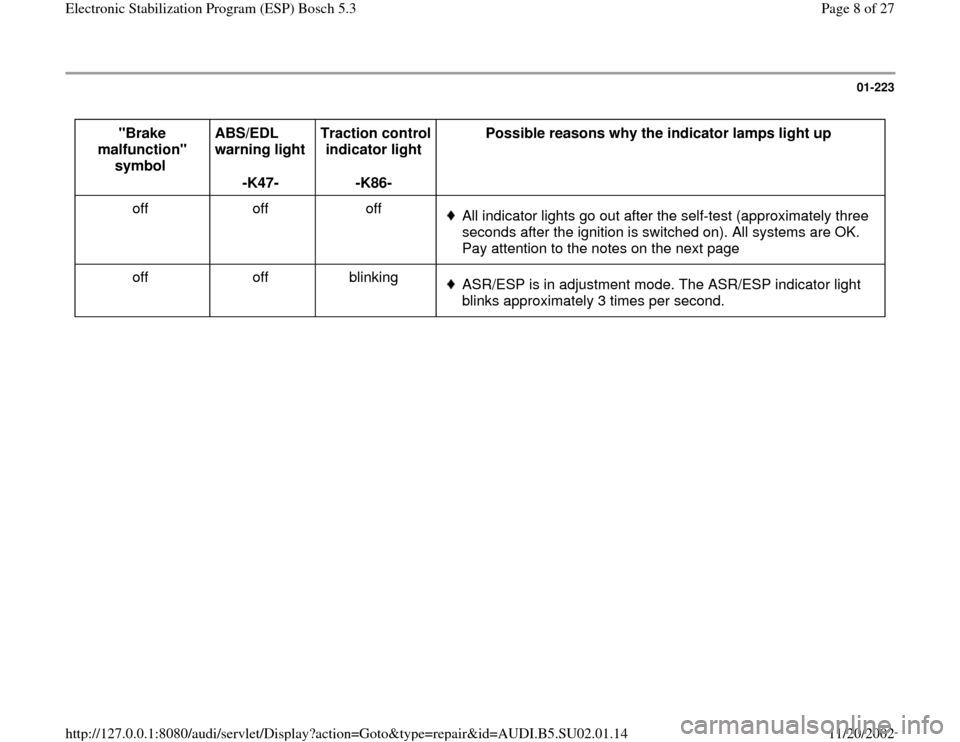
01-223
"Brake
malfunction"
symbol ABS/EDL
warning light
-K47- Traction control
indicator light
-K86- Possible reasons why the indicator lamps light up
off off off
All indicator lights go out after the self-test (approximately three
seconds after the ignition is switched on). All systems are OK.
Pay attention to the notes on the next page
off off blinking ASR/ESP is in adjustment mode. The ASR/ESP indicator light
blinks approximately 3 times per second.
Pa
ge 8 of 27 Electronic Stabilization Pro
gram
(ESP
) Bosch 5.3
11/20/2002 htt
p://127.0.0.1:8080/audi/servlet/Dis
play?action=Goto&t
yp
e=re
pair&id=AUDI.B5.SU02.01.14
Page 9 of 27
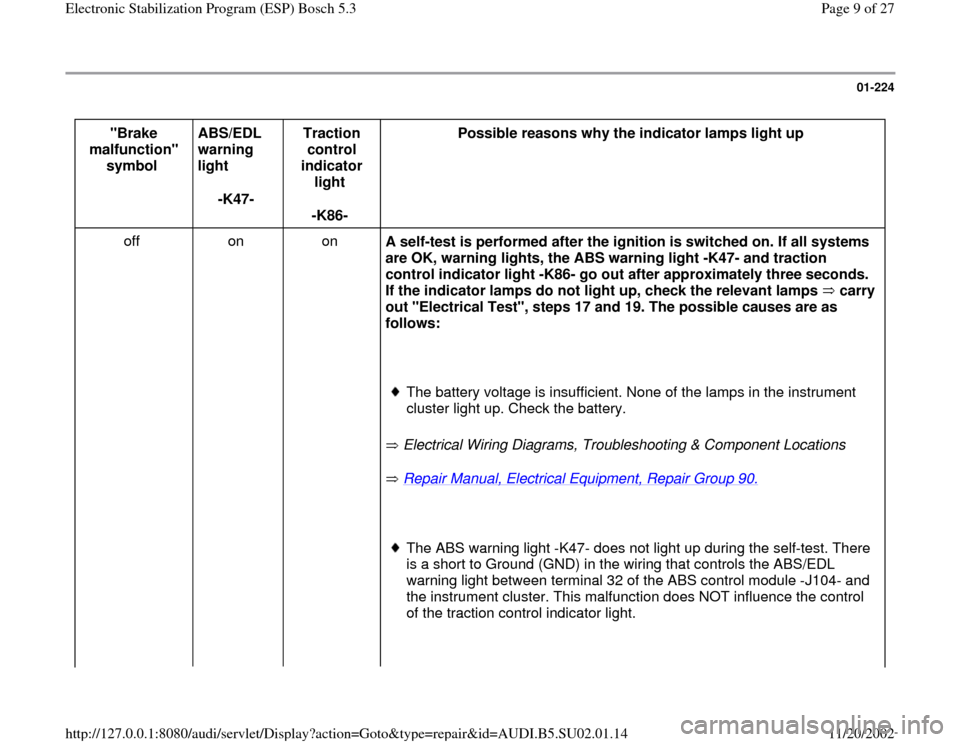
01-224
"Brake
malfunction"
symbol ABS/EDL
warning
light
-K47- Traction
control
indicator
light
-K86- Possible reasons why the indicator lamps light up
off on on
A self-test is performed after the ignition is switched on. If all systems
are OK, warning lights, the ABS warning light -K47- and traction
control indicator light -K86- go out after approximately three seconds.
If the indicator lamps do not light up, check the relevant lamps carry
out "Electrical Test", steps 17 and 19. The possible causes are as
follows:
Electrical Wiring Diagrams, Troubleshooting & Component Locations
Repair Manual, Electrical Equipment, Repair Group 90.
The battery voltage is insufficient. None of the lamps in the instrument
cluster light up. Check the battery. The ABS warning light -K47- does not light up during the self-test. There
is a short to Ground (GND) in the wiring that controls the ABS/EDL
warning light between terminal 32 of the ABS control module -J104- and
the instrument cluster. This malfunction does NOT influence the control
of the traction control indicator light.
Pa
ge 9 of 27 Electronic Stabilization Pro
gram
(ESP
) Bosch 5.3
11/20/2002 htt
p://127.0.0.1:8080/audi/servlet/Dis
play?action=Goto&t
yp
e=re
pair&id=AUDI.B5.SU02.01.14
Page 10 of 27
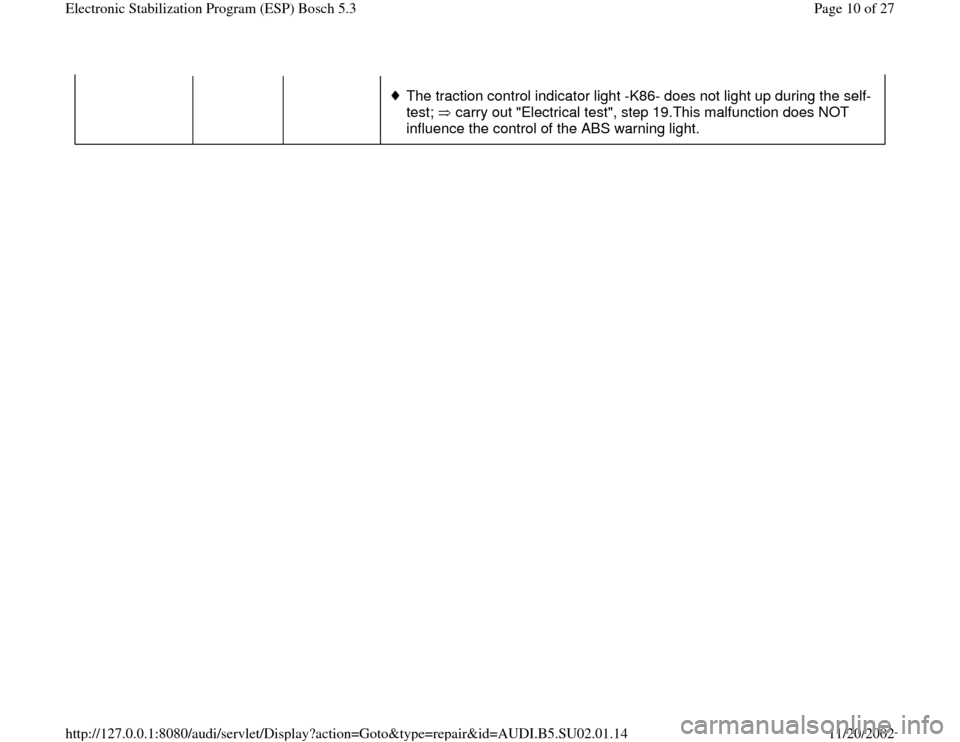
The traction control indicator light -K86- does not light up during the self-
test; carry out "Electrical test", step 19.This malfunction does NOT
influence the control of the ABS warning light.
Pa
ge 10 of 27 Electronic Stabilization Pro
gram
(ESP
) Bosch 5.3
11/20/2002 htt
p://127.0.0.1:8080/audi/servlet/Dis
play?action=Goto&t
yp
e=re
pair&id=AUDI.B5.SU02.01.14